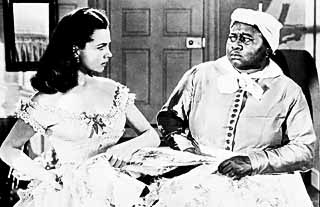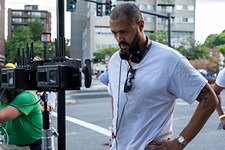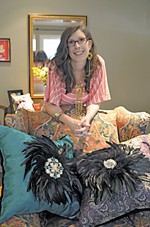Gone With the Wind: The Making of the Legend
Everything you ever wanted to know about GWTW -- in one work
Reviewed by Stephen MacMillan Moser, Fri., Feb. 23, 2001

GONE WITH THE WIND: THE MAKING OF THE LEGEND
D: David Hinton (1989); narration by Christopher Plummer, with appearances by Evelyn Keyes, Ann Rutherford, and key members of Selznick's staff and crew.
Everything you ever wanted to know about GWTW -- in one work. There is the historical dish, like when Margaret Mitchell recalls her mother driving her out to see the ruined plantations around Atlanta and telling her that she'd better learn to survive. There are testimonies about GWTW being one of the most beloved movies of all time -- even when it's not politically correct to love the movie. Making of the Legend is a documentary combining spoken word, letters, memos, newsclips, diaries, and re-creations in a comprehensive style that predates Ken Burns. It is a dizzying montage of information and images that tells the story of the film -- a monumental achievement that is one of the few films to not disappoint the lovers of the book. Selznick purchased the rights to the story for $50,000, a fortune at the time for a story so sprawling that it was impossible to visualize on the screen. As a superb craftsman, even Selznick was intimidated -- not just by the scope of the story, but by the public's obsession with it. So it was with tender care that he began preproduction and scriptwriting on this monster. The footage that we see in the finished version of GWTW shows only a small part of the passion, heartache, and bloodletting that went on behind the scenes. Most impressive is the existing array of screen tests that were done for the movie -- evidence that the much-ballyhooed "Search for Scarlett O'Hara" was far more than hype from a hotheaded publicist. Showing dozens of would-be Scarletts, Melanies, Ashleys, and Belles, the most stunning footage are the multiple and lengthy tests that Paulette Goddard did for the role of Scarlett. She exhibits a cunning and slyness that are perfect for Scarlett, and the news reports go crazy announcing her unconfirmed appointment. It is the sheer number of tests that Goddard did that is amazing; she had every reason on earth to believe she had the part. She would have been delightful as Scarlett, but could she have made Scarlett into the legend that Vivian Leigh did? Fraught with tension, shooting began without Scarlett having been cast. The story behind the filming of the burning of Atlanta is riveting in its detail, showing how old sets from King Kong and Birth of a Nation, among others, were burned and then multiplied on film to create the effect. It was during the filming of this sequence that Selznick's brother Myron legendarily arrived on the set with a gorgeous young woman in tow and said to the producer, "I'd like you to meet your Scarlett." And the film's fate was sealed with the casting of the tragic and incandescent Vivian Leigh. Although Selznick was reviled by Hedda Hopper, among others, for casting an English girl instead of a red-blooded American, even Margaret Mitchell herself said, "Better an English girl than a Yankee." Goddard had been frontrunner until the last second when Leigh waltzed in and stole the part from under her nose. It must have been an unbearably bitter disappointment, and Goddard never again realized the potential she showed in these screen tests. But this story is only a small facet of what happened behind the scenes. After a time, miles of film were scrapped when original director George Cukor was fired and replaced by Victor Fleming. There's quite a tale behind that, which neither the documentary, nor we, will go into. The personal dramas are many, with Selznick's drug use, health problems, and subsequent breakdown addressed. The volume of information collected here is awesome. Butterfly McQueen speaks about her role as Prissy ("I wouldn't let them slap me, but I thought Prissy needed to be slapped, " she says. "I thought she was horrid.") There is footage of Hattie McDaniel's Academy Award speech, which is so sincere and touching that it must be considered a gift that we can still see it. It was a scandal that the movie cost three million dollars to make, a jaw-droppingly small figure for a movie that paid for itself many, many times over -- and that's just in financial terms.










